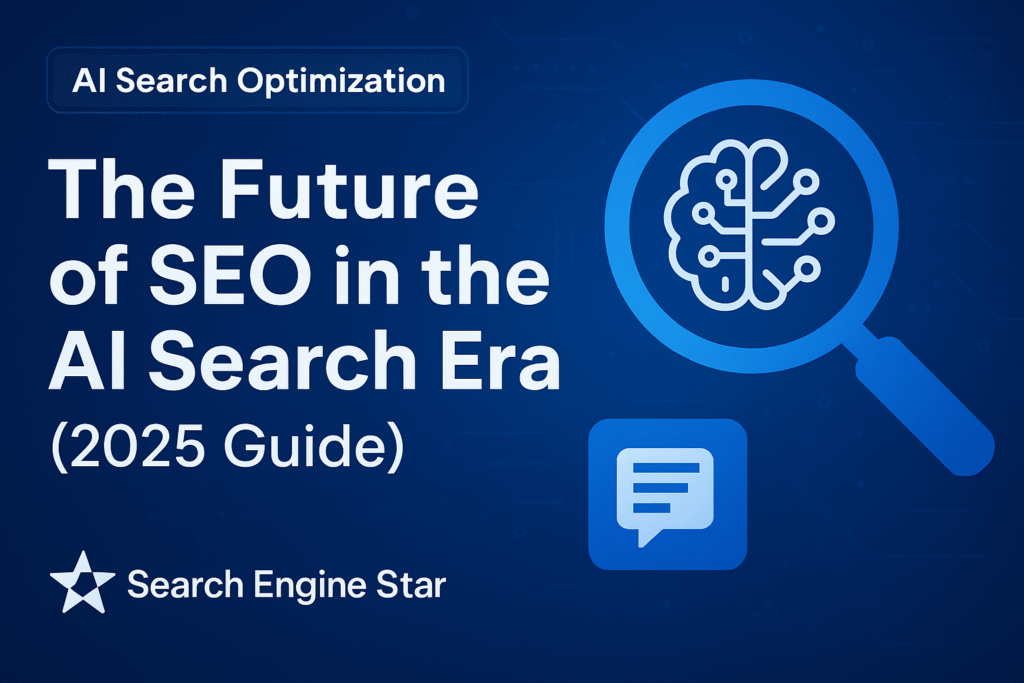Artificial intelligence has fundamentally transformed the search landscape. The traditional SEO playbook—built on keywords, backlinks, and on-page optimization—is rapidly evolving into something much more advanced: AI Search Optimization.
With tools like Google’s AI Overview, Microsoft Copilot, and Perplexity AI, users no longer rely solely on blue links. Instead, they expect conversational, context-rich answers generated in real time. That shift is redefining how visibility, authority, and discovery work online.
In this comprehensive 2025 guide, we’ll break down what AI Search Optimization means, how it differs from traditional SEO, and how you can adapt your content strategy to stay visible in the era of AI-powered search engines.
What Is AI Search Optimization?
AI Search Optimization (AISO) is the practice of optimizing your website’s content, structure, and authority so that it can be discovered, understood, and cited by AI-driven search engines—especially those powered by large language models (LLMs).
Unlike traditional SEO, which focuses on ranking higher in search engine results pages (SERPs), AISO is about making your content useful to AI systems that generate answers directly for users.
In other words:
Traditional SEO helps humans find your page.
AI Search Optimization helps AI find—and use—your content in its answers.
AI-driven search models extract information, summarize it, and deliver concise, conversational responses. Your visibility depends on whether your content is chosen as a trusted citation or embedded source within those AI-generated results.
How AI Search Engines Work
To optimize for AI search, you need to understand how these systems interpret and process data. Here’s a simplified view of the process:
1. Query Interpretation (Natural Language Understanding)
AI search engines like Gemini or GPT-4 analyze a query’s intent, not just its keywords. They understand tone, context, and emotional cues. For instance, “how to stay productive without burnout” prompts wellness-oriented results—not just productivity hacks.
2. Semantic Retrieval and Indexing
Instead of focusing on keyword matches, AI models retrieve semantically relevant content—pieces that align with user intent and contain structured, informative insights.
3. Content Synthesis and Generation
The model then synthesizes information from multiple high-trust sources, producing a well-rounded, conversational answer—often accompanied by citations.
4. Presentation and Citations
Finally, the answer appears in AI Overview boxes, chat interfaces, or voice responses. Your content might appear as a clickable citation, a summary snippet, or an implied mention—boosting brand exposure and credibility.
Why AI Search Optimization Matters in 2025
1. AI Is Reshaping User Search Behavior
More than 40% of Gen Z and Millennials now prefer conversational queries through tools like ChatGPT or Google AI Overview. This is not a passing trend—it’s the new normal.
2. Zero-Click Search Is the New Reality
AI-generated results often deliver answers directly—before a user clicks anything. Your visibility now depends on being cited inside those AI summaries, not just ranking on page one.
3. Voice and Assistant Search Depend on AI Summaries
Voice assistants like Siri and Alexa pull from AI-summarized data. If your content powers those answers, you gain high-impact exposure—without relying on traditional organic clicks.
4. Trust and Credibility Drive Visibility
AI systems avoid misinformation. They prefer authoritative, transparent sources—so E-E-A-T (Experience, Expertise, Authoritativeness, Trustworthiness) is more crucial than ever.
Traditional SEO vs. AI Search Optimization
| Aspect | Traditional SEO | AI Search Optimization |
| Primary Goal | Rank high on SERPs | Be cited in AI-generated answers |
| Optimization Target | Search engine algorithms | AI models (GPT-4, Gemini, Claude, Perplexity) |
| Query Matching | Keyword-based | Intent and semantic-based |
| Content Structure | Page-level optimization | Clustered, structured, AI-readable |
| Visibility Metric | Click-through rate | Citations, mentions, AI visibility |
| User Experience | Clicks and navigation | Direct answers and conversations |
Key Strategies for AI Search Optimization
1. Create Structured, AI-Friendly Content
AI models prefer structured, easy-to-parse data.
Action Steps:
- Use logical headings (H1–H3) and bullet points.
- Add clear takeaways, summaries, and FAQs.
- Implement schema markup (Article, HowTo, FAQPage).
- Use semantic keywords that align with user intent.
- Add definition boxes or quick “answer paragraphs.”
2. Build Topical Authority Through Content Clusters
AI rewards ecosystems of related content.
Action Steps:
- Develop pillar pages with deep topic coverage.
- Support them with interlinked cluster articles.
- Regularly update older posts with new data.
- Focus on one niche to strengthen domain authority.
3. Prioritize Trust, Expertise, and Transparency
AI systems amplify trustworthy sources.
Action Steps:
- Add author bios with credentials and real-world experience.
- Link to credible data sources.
- Publish original studies or insights.
- Get mentioned in reputable publications and podcasts.
- Ensure technical SEO health (speed, SSL, mobile-friendliness).
4. Write Conversational, Human-Centric Content
AI models replicate natural conversation—your tone should too.
Action Steps:
- Write like you’re explaining something to a friend.
- Use examples, analogies, and real-life scenarios.
- Add Q&A sections for voice and chat-based queries.
- Keep sentences short, clear, and purposeful.
5. Deliver Fast, Direct Answers
AI systems scan for concise, answer-ready sections.
Action Steps:
- Start each article with a summary or TL;DR.
- Use tables, checklists, and stats with citations.
- Add answer boxes under key headers.
- Format content for scanning (bold keywords, bullet lists).
How to Measure AI Search Visibility
AI search success isn’t about traffic alone—it’s about influence within AI ecosystems.
Track Key AI Visibility Metrics:
- AI Citations and Mentions – See if your content appears in AI results on platforms like Google AI Overview, Perplexity, and Copilot.
- Branded Search Growth – Watch for brand-name query increases in Google Search Console.
- Voice Search Visibility – Test your content’s voice assistant responses (Google, Alexa, Siri).
- Implied Mentions – Track paraphrased brand references using the Search Engine Star GEO Tool.
- Quality Engagement – Focus on dwell time, return visits, and conversions—AI traffic is high-value.
Introducing Search Engine Star’s GEO Tool
To thrive in AI-driven search, you need visibility intelligence beyond keyword rankings. That’s where Search Engine Star’s GEO Tool comes in.
It’s an AI Visibility Analytics Platform designed to help SEO professionals and brands measure how their content performs within generative search environments.
With the GEO Tool, you can:
✅ Track AI Mentions & Citations — See when your content is referenced across Google AI Overview, ChatGPT, Bing Copilot, and Perplexity AI.
✅ Benchmark Competitors — Compare your AI visibility score to others in your niche.
✅ Discover High-Performing Content — Identify which pages are most often used in AI-generated summaries.
✅ Monitor Visibility Changes — Get alerts when your content is replaced or visibility drops.
✅ Measure Your AI Visibility Score — Access a proprietary metric showing how well your brand is performing in AI search.
The GEO Tool answers one vital question:
“Is my content being used in AI-generated answers?”
Future-Proofing Your SEO in the AI Search Era
The shift to AI-first search is irreversible. To stay competitive:
- Publish unique, data-driven insights AI can’t easily replicate.
- Diversify with multimedia content (videos, podcasts).
- Strengthen your E-E-A-T profile.
- Optimize for semantic intent, not just keywords.
- Use tools like the Search Engine Star GEO Tool to monitor and enhance your AI search performance.
Final Thoughts
The rise of AI-powered search engines represents the most significant evolution in SEO since the dawn of Google. Success in 2025 and beyond will belong to brands that:
- Create structured, expert-led content.
- Write conversationally for human and AI audiences.
- Build trust and authority within their niche.
- Track and optimize their AI visibility continuously.
AI Search Optimization isn’t the future—it’s the present.
If your content isn’t visible to AI, it might as well be invisible to users.
FAQs
1. How is AI Search Optimization changing SEO?
AI SEO shifts focus from backlinks to brand citations and co-occurrence. It’s about training AI systems to trust and reuse your content.
2. What influences AI citation frequency?
Factors include structured formatting, semantic clarity, schema usage, freshness, and authority signals.
3. How can I optimize for AI search?
Use answer-first formatting, structured markup, and conversational writing to increase citation likelihood.
4. Are there AI platform-specific tactics?
Yes. Perplexity favors multimedia content, ChatGPT prefers natural tone and clarity, and Google SGE rewards strong E-E-A-T and schema.
5. How do I measure AI visibility success?
Track citation frequency, branded search growth, and your Search Engine Star GEO Visibility Score to measure AI-driven impact.

Joseph is an SEO Specialist and the founder of Search Engine Star, a results-driven SEO agency dedicated to helping businesses boost visibility, rank higher, and grow through smart search strategies. With years of experience in eCommerce SEO, AI-driven optimization, and SEO copywriting, Joseph has helped brands increase organic traffic and secure top spots in Google’s AI Overviews and featured snippets.

